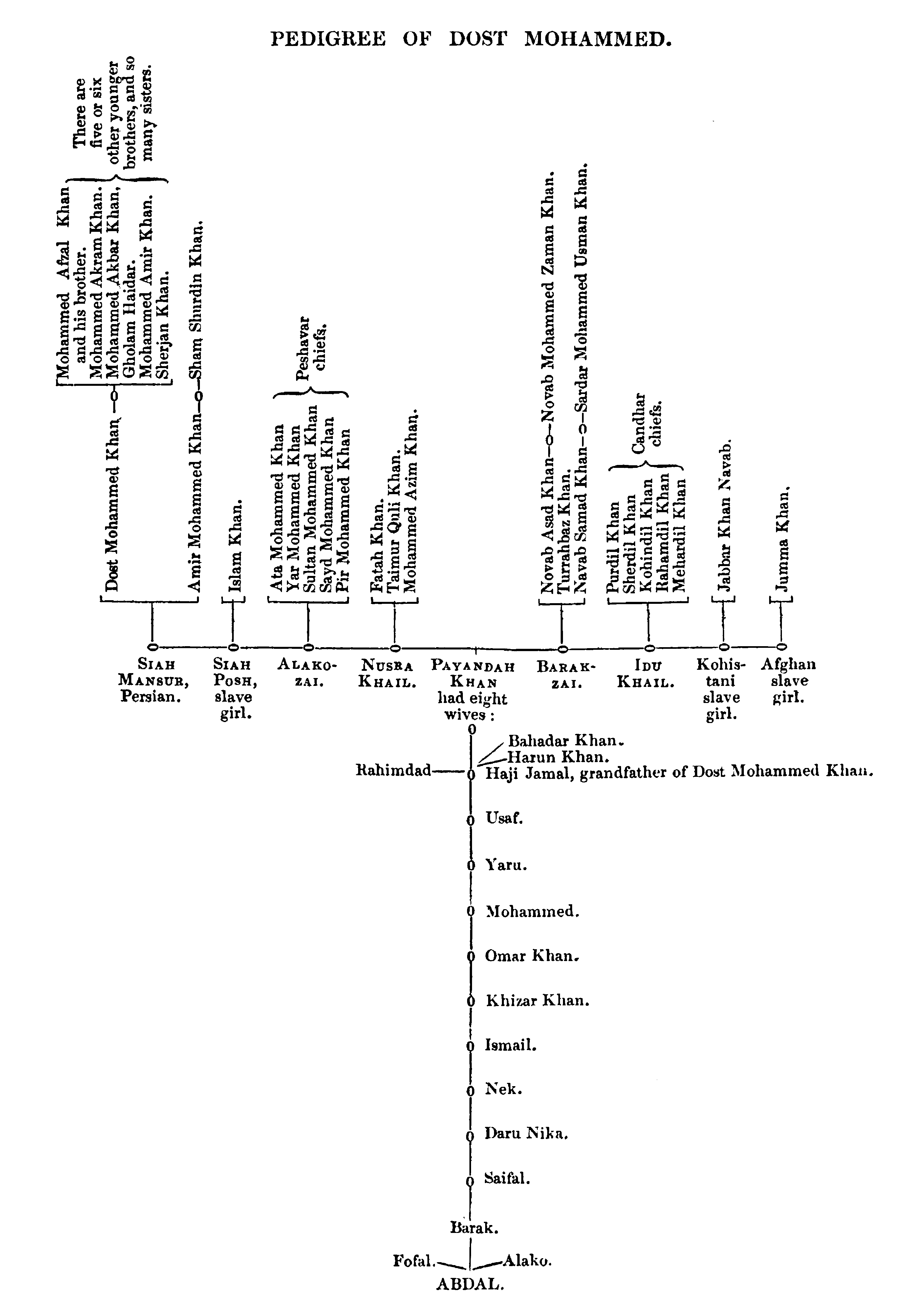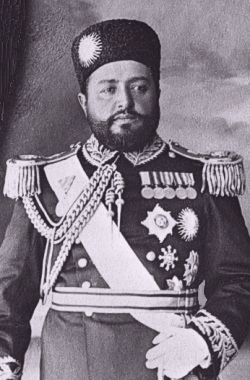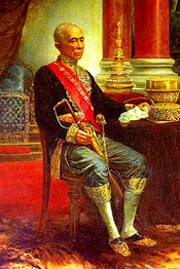|
Yar Muhammad Khan Alakozai
Yar Muhammad Khan Alakozai bin Abdullah Khan () was the vizier of the Principality of Herat from 1829 to 1842, and the ruler of Herat from 1842 until 1851. He was born in 1790 into the Alakozai tribe. In 1829, he became vizier, or chief minister, of Herat. In 1842, he deposed his Emir, Kamran Shah Durrani, and became the new ruler of Herat. He expanded the country's domains to the Chahar Wilayat and Lash-Joveyn before dying in 1851. He held a marriage alliance with Akbar Khan, a Barakzai prince, general, and later the emir Emir (; ' (), also Romanization of Arabic, transliterated as amir, is a word of Arabic language, Arabic origin that can refer to a male monarch, aristocratic, aristocrat, holder of high-ranking military or political office, or other person po ... of Afghanistan for a year. References {{DEFAULTSORT:Yar Mohammad Khan Alakozai 1851 deaths Emirs of Afghanistan Pashtun people ... [...More Info...] [...Related Items...] OR: [Wikipedia] [Google] [Baidu] |
Vizier
A vizier (; ; ) is a high-ranking political advisor or Minister (government), minister in the Near East. The Abbasids, Abbasid caliphs gave the title ''wazir'' to a minister formerly called ''katib'' (secretary), who was at first merely a helper but afterwards became the representative and successor of the ''dapir'' (official scribe or secretary) of the Sasanian Empire, Sassanian kings. In modern usage, the term has been used for government Minister (government), ministers in much of the Middle East and beyond. Several alternative spellings are used in English, such as ''vizir'', ''wazir'', and ''vezir''. Etymology Vizier may be derived from the Arabic ''wazara'' (), from the Semitic root ''W-Z-R''. The word is mentioned in the Quran, where Aaron is described as the ''wazir'' (helper) of Moses, as well as the word ''wizr'' (burden) which is also derived from the same root. It was later adopted as a title, in the form of ''wazīr āl Muḥammad'' () by the proto-Shi'a leaders ... [...More Info...] [...Related Items...] OR: [Wikipedia] [Google] [Baidu] |
Herat (1793–1863)
The Principality of Herat (), the Emirate of Herat (), the Herat Khanate () or simply Herat () was a state in Afghanistan from 1793 to 1863, and one of the three main khanates that existed in 19th century Afghanistan (the others being the khanates of Emirate of Afghanistan, Kabul and Principality of Kandahar, Kandahar) after the breakup of the Durrani Empire. In 1793, Timur Shah Durrani died and Mahmud Shah Durrani, Mahmud Shah took control of Herat, making the town and the surrounding region independent. In 1801, the principality was revived by Firuz al-Din Mirza. Herat was prosperous under his reign in spite of multiple invasions by Qajar Iran. In 1818, Mahmud and later Kamran Shah Durrani, Kamran Shah took over, attempting to keep the region stable as a buffer region between the Barakzai dynasty, Barakzais and Qajars. However, the region was devastated by constant infighting and further Iranian invasions. The Siege of Herat (1837–1838), Iranian invasion of 1837 weakened the ... [...More Info...] [...Related Items...] OR: [Wikipedia] [Google] [Baidu] |
Alakozai
Alakozai ( - meaning ''descendant of Alako'' in Pashto) is a Pashtun tribe in Afghanistan. They are one of the four tribes of the Zirak tribal confederacy of Durrani Pashtuns. Variations Spelling variations include Alakozi, Alakoozi, Alekozai, Alekuzei, Alikozai, Alakozay, Alkozai, Alokzai, Hulakozai, Alecozay, Alikusi, and Alakuzei. History Their eponymous ancestor is claimed to be Alako, son of King Zirak Khan, son of Abdal, son of Tareen. Distribution The Alkozay people are found primarily in Helmand, Kandahar, Kabul, Laghman, Kunar Sarkani District and Herat provinces in Afghanistan, and form the majority of the population in the Sangin District. Jaldak, which is located 110 km northeast of Kandahar, is the original domicile of the Alkozay tribe. The Alkozay people stretch from Farah to Kandahar, and constitute a majority in the Arghandab District of Kandahar. The Arghandab district was given to the Alkozay tribe by King Nadir Shah, who brought down the S ... [...More Info...] [...Related Items...] OR: [Wikipedia] [Google] [Baidu] |
Kamran Shah Durrani
Kamran Mirza Durrani (Pashto/Persian: کامران میرزا دورانی) was the last Durrani ruler of Herat from 1826 to 1842. He was the son and successor of Mahmud Shah Durrani (). During Kamran Mirza's early life, a lengthy struggle for control of the capital Kabul occurred between his father and his father's half-brother, Shah Shujah Durrani (). In this period, Kamran Mirza governed the city of Kandahar, while his uncle Firuz al-Din Mirza ruled Herat under Iranian suzerainty. When Firuz al-Din rebelled in 1814, Kamran Mirza suppressed the revolt. In 1818, the Durrani minister Fateh Khan Barakzai deposed Firuz al-Din as ruler of Herat; his troops then plundered the city, and his brother Dost Mohammad Khan raped Kamran Mirza's sister. In revenge, Kamran Mirza captured Fateh Khan and had him executed, which prompted a rebellion by Fateh Khan's brothers. This forced Mahmud Shah and Kamran Mirza to retreat to Herat, the last Durrani stronghold. In 1826, Kamran Mirza became the ... [...More Info...] [...Related Items...] OR: [Wikipedia] [Google] [Baidu] |
Chahar Wilayat
The Chahar Wilayat () was a historical region in northern Afghanistan, covering modern-day Faryab, Jowzjan, and Sar-e Pol Provinces. It was named after the 4 former khanates in the area: Maymana Maymana ( Persian/ Uzbek/Pashto: ) is the capital city of Faryab Province in northwestern Afghanistan, near the Afghanistan–Turkmenistan border. It is approximately northwest of the country's capital Kabul, and is located on the Maymana Riv ..., Sar-i Pul, Sheberghan, and Andkhui. Maimana was traditionally the most powerful and influential of the khanates. The Chahar Wilayat's population was majority Uzbek. References Historical regions Sar-e Pol Province Jowzjan Province Faryab Province Uzbeks {{Afghanistan-geo-stub ... [...More Info...] [...Related Items...] OR: [Wikipedia] [Google] [Baidu] |
Lash Wa Juwayn District
Lash wa Juwayn (also transliterated Lash o Jawain) is a district in Farah Province, Afghanistan Afghanistan, officially the Islamic Emirate of Afghanistan, is a landlocked country located at the crossroads of Central Asia and South Asia. It is bordered by Pakistan to the Durand Line, east and south, Iran to the Afghanistan–Iran borde .... The main town, also called Lash wa Juwayn, is situated at 508 m elevation by Daryache-ye Sistan lake. Populated places * Tojg References External links Map of SettlementsAIMS, May 2002 Districts of Farah Province {{Farah-geo-stub ... [...More Info...] [...Related Items...] OR: [Wikipedia] [Google] [Baidu] |
Wazir Akbar Khan
Wazir Akbar Khān (1816–1847) also known as Mohammad Akbar Khān or Amīr Akbar Khān was a Barakzai prince and military commander who served as emir of Afghanistan from 1842 to 1843. He also served as vizier and heir apparent to his father, Emir Dost Mohammad Khan (), until his death in 1847. Wazir Akbar Khan's fame began with the 1837 Battle of Jamrud. He was militarily active in the First Anglo-Afghan War, which lasted from 1839 to 1842. He is prominent for his leadership of the national party in Kabul from 1841 to 1842, and his massacre of Elphinstone's army at the Gandamak pass before the only survivor, the assistant surgeon William Brydon, reached the besieged garrison at Jalalabad on 13 January 1842. Wazir Akbar Khan became the emir of Afghanistan in May 1842, and ruled until Dost Mohammad Khan's return in 1843. In 1847 Wazir Akbar Khan died of cholera. Early life Akbar Khan was born to an Afghan Barakzai Pashtun family as Mohammad Akbar Khan in 1816 to Dost Mo ... [...More Info...] [...Related Items...] OR: [Wikipedia] [Google] [Baidu] |
Barakzai Dynasty
The Barakzai dynasty (, "Sons of Barak"), also known as the Muhammadzai dynasty ("the ruling sub-clan of the Barakzai"), ruled what is now Afghanistan from 1823 to 1978, when the monarchy ended de jure under Musahiban Mohammad Zahir Shah and de facto under his cousin Mohammad Daoud Khan. The Barakzai dynasty was established by Dost Mohammad Khan after the Durrani Empire of Ahmad Shah Durrani was removed from power. As the Pahlavi era in Iran, the Muhammadzai era was known for its progressivist modernity, practice of Sufism, peaceful security and neutrality, in which Afghanistan was referred to as the "Switzerland of Asia". History and background Ancestral background The Barakzai claim descent from the children of Israel in a direct line through the first Israeli King Saul, whose family intermarried with the family of his successor King David. King Saul's grandson the Prince (Malak) Afghana was grown up by King Solomon, acting as his commander in chief and Manager ... [...More Info...] [...Related Items...] OR: [Wikipedia] [Google] [Baidu] |
Prince
A prince is a male ruler (ranked below a king, grand prince, and grand duke) or a male member of a monarch's or former monarch's family. ''Prince'' is also a title of nobility (often highest), often hereditary, in some European states. The female equivalent is a princess. The English word derives, via the French word ''prince'', from the Latin noun , from (first) and (head), meaning "the first, foremost, the chief, most distinguished, noble ruler, prince". In a related sense, now not commonly used, all more or less sovereign rulers over a state, including kings, were "princes" in the language of international politics. They normally had another title, for example king or duke. Many of these were Princes of the Holy Roman Empire. Historical background The Latin word (older Latin *prīsmo-kaps, ), became the usual title of the informal leader of the Roman senate some centuries before the transition to empire, the '' princeps senatus''. Emperor Augustus establishe ... [...More Info...] [...Related Items...] OR: [Wikipedia] [Google] [Baidu] |
Emir
Emir (; ' (), also Romanization of Arabic, transliterated as amir, is a word of Arabic language, Arabic origin that can refer to a male monarch, aristocratic, aristocrat, holder of high-ranking military or political office, or other person possessing actual or ceremonial authority. The title has a history of use in West Asia, East Africa, West Africa, Central Asia, and South Asia. In the modern era, when used as a formal monarchical title, it is roughly synonymous with "prince", applicable both to a son of a hereditary monarch, and to a reigning monarch of a sovereign principality, namely an emirate. The female, feminine form is emira ( '), with the same meaning as "princess". Prior to its use as a monarchical title, the term "emir" was historically used to denote a "commander", "general", or "leader" (for example, Amir al-Mu'min). In contemporary usage, "emir" is also sometimes used as either an honorary or formal title for the head of an Islamic, or Arab (regardless of relig ... [...More Info...] [...Related Items...] OR: [Wikipedia] [Google] [Baidu] |
1851 Deaths
Events January–March * January 11 – Hong Xiuquan officially begins the Taiping Rebellion in China, one of the bloodiest revolts that would lead to 20 million deaths. * January 15 – Christian Female College, modern-day Columbia College (Missouri), Columbia College, receives its charter from the Missouri General Assembly. * January 23 – The flip of a coin, subsequently named the Portland Penny, determines whether a new city in the Oregon Territory will be named after Boston, Massachusetts, or Portland, Maine, with Portland, Oregon, Portland winning. * January 28 – Northwestern University is founded in Illinois. * February 1 – ''Brandtaucher'', the oldest surviving submersible craft, sinks during acceptance trials in the German port of Kiel, but the designer, Wilhelm Bauer, and the two crew escape successfully. * February 6 – Black Thursday (1851), Black Thursday occurs in Australia as Bushfires in Australia, bushfires sweep across ... [...More Info...] [...Related Items...] OR: [Wikipedia] [Google] [Baidu] |







